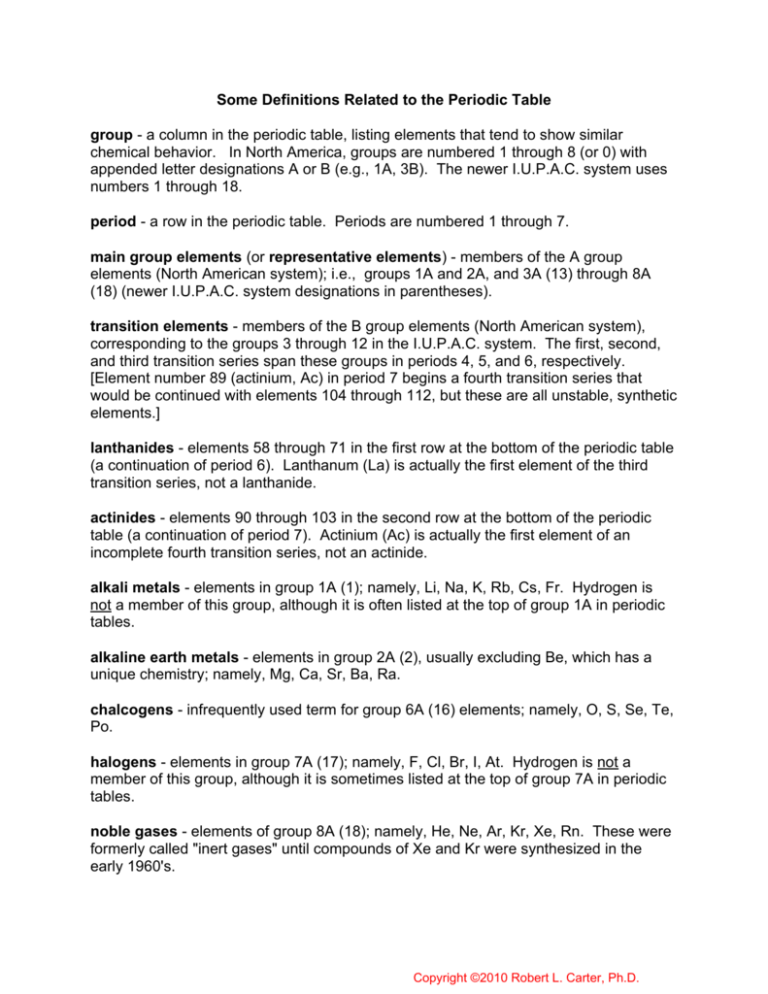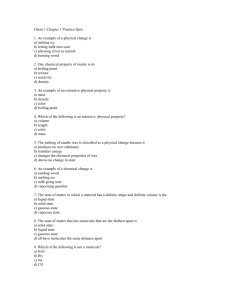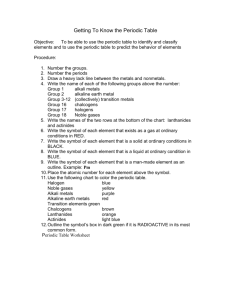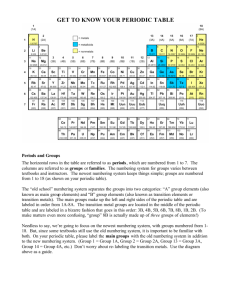Some Definitions Related to the Periodic Table group
advertisement

Some Definitions Related to the Periodic Table group - a column in the periodic table, listing elements that tend to show similar chemical behavior. In North America, groups are numbered 1 through 8 (or 0) with appended letter designations A or B (e.g., 1A, 3B). The newer I.U.P.A.C. system uses numbers 1 through 18. period - a row in the periodic table. Periods are numbered 1 through 7. main group elements (or representative elements) - members of the A group elements (North American system); i.e., groups 1A and 2A, and 3A (13) through 8A (18) (newer I.U.P.A.C. system designations in parentheses). transition elements - members of the B group elements (North American system), corresponding to the groups 3 through 12 in the I.U.P.A.C. system. The first, second, and third transition series span these groups in periods 4, 5, and 6, respectively. [Element number 89 (actinium, Ac) in period 7 begins a fourth transition series that would be continued with elements 104 through 112, but these are all unstable, synthetic elements.] lanthanides - elements 58 through 71 in the first row at the bottom of the periodic table (a continuation of period 6). Lanthanum (La) is actually the first element of the third transition series, not a lanthanide. actinides - elements 90 through 103 in the second row at the bottom of the periodic table (a continuation of period 7). Actinium (Ac) is actually the first element of an incomplete fourth transition series, not an actinide. alkali metals - elements in group 1A (1); namely, Li, Na, K, Rb, Cs, Fr. Hydrogen is not a member of this group, although it is often listed at the top of group 1A in periodic tables. alkaline earth metals - elements in group 2A (2), usually excluding Be, which has a unique chemistry; namely, Mg, Ca, Sr, Ba, Ra. chalcogens - infrequently used term for group 6A (16) elements; namely, O, S, Se, Te, Po. halogens - elements in group 7A (17); namely, F, Cl, Br, I, At. Hydrogen is not a member of this group, although it is sometimes listed at the top of group 7A in periodic tables. noble gases - elements of group 8A (18); namely, He, Ne, Ar, Kr, Xe, Rn. These were formerly called "inert gases" until compounds of Xe and Kr were synthesized in the early 1960's. Copyright ©2010 Robert L. Carter, Ph.D. metals - elements in groups 1A (1) and 2A (2), the transition elements, the lanthanides and actinides, and the heavier elements in groups 3A (13) through 5A (15) that lie below the stair step shown on some periodic tables. At room temperature metals are shiny solids (except mercury and gallium above 29.78oC) that are malleable, ductile, and conductive of heat and electricity. Metals characteristically are cations in their ionic compounds. nonmetals - the elements in groups 4A (14) through 7A (17) that lie above the stair step on some periodic tables. Individual nonmetals may be either solids, liquids, or gases at room temperature. They are poor conductors of heat and electricity. Nonmetals characteristically are anions, when existing as monatomic ions in ionic compounds. When combined with other nonmetals, they typically form molecular compounds or complex ions. metalloids - the elements B, Si, Ge, As, Sb, Te, At, which lie along the stair step shown on some periodic tables. All are solids with semi-metallic properties. They show poorer conductivity relative to metals and may be semiconductors (e.g., Si and Ge). Copyright ©2010 Robert L. Carter, Ph.D.






